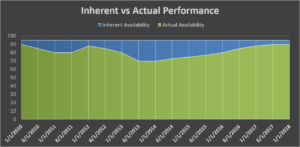Why You Cannot Operate Above the Inherent Capability Sustainably
 I recently had the opportunity to teach a Body of Knowledge course, which was full of great questions from the students. One of the questions was about inherent vs. actual availability. This had me thinking about the choice that organizations make on how they choose to run their business and more importantly, their resources.
I recently had the opportunity to teach a Body of Knowledge course, which was full of great questions from the students. One of the questions was about inherent vs. actual availability. This had me thinking about the choice that organizations make on how they choose to run their business and more importantly, their resources.
There are many times when a resource is operated at Peak Inherent capability, with the intention of getting the most out of the resource. while this is a good practice, many organizations try to operate the resource at greater than the inherent capability of the resource. So, what does this do to the resource? Well, it could mean short-term financial gains, achieving the schedule, or if done for a sustained period of time, it could be detrimental to the resource.
What is Inherent Capability?
Inherent Capability is often the design limitations of the resource. For a piece of equipment, it could be the rated run speed, the maximum time between maintenance, etc. These constraints are often the product of the design specifications, the quality of the engineering, fabrication, and installation of the equipment.
The same goes for the human resources within an organization. People need to sleep, eat, socialize, etc. Continually operating production and maintenance with a high level of overtime is not sustainable, it will burn people out. This will lead to high turn over or people no longer signing up for overtime when it is truly needed.
It is important to note that no matter what maintenance is performed, the ability of the resource to operate sustainably at or above the inherent capability is very limited without design changes.
The Detriment of Operating Above Inherent Capability
With it being detrimental, why do organization try to operate the resource above the inherent capability? I believe it is often due to looking at the short-term performance of the organization, without regard to the long-term sustainability of the resource. There is tremendous pressure put on public companies to meet the quarterly target, and as such the senior execs are compensated on that performance. This often leads to sacrificing what is the best long-term for the organization to meet those short-term goals. While there needs to be focus on short-term goals to deliver the long-term objectives, they must be aligned.
So, what happens to the resources if this tradeoff is made? Well, typically the equipment base will deteriorate quicker. This will result in either more significant maintenance activiti3s, or a steadily growing rate of failure. The organization will have to deal with more maintenance costs, not on a linear scale, but an exponential scale, as the equipment is operating outside of its capabilities. The other option is to have an increase in capital expenditures as assets are having to be rebuilt or replaced more frequently. Either way, the life cycle cost of the equipment is increased, and the organization has a reduced Return On Net Assets (RONA).
If the organizations choose to operate its equipment within its design parameters but chooses to operate it at higher utilization, they could hire more staff, or leverage over time. If it is seen as a short-term increase in utilization, there is a great argument for the use of overtime. It does take time to train new staff, achieve a consistent output, etc. But what if the expected utilization increase is not just a few weeks? Then the hiring of some new staff is critical.
What Can Maintenance and Reliability Professionals Do?
I believe that the maintenance professional can influence the organization in making the right decisions around operating the resources within or above the inherent capability.
- They can support in the information stage, where there are questions of what the equipment is currently doing and what can it do, by understanding the design specifications. Once the design is understood, the maintenance professional can develop models of different operating changes, such as changes in human resource requirements, changes in maintenance time, spares demand, etc.
- If the decision is made to operate the equipment above its design capabilities, revise the maintenance strategy to ensure maximum uptime from the asset
- Advocate for assets better long-term solution, such as identifying the need for new equipment, or at a minimum, identify the bottlenecks in the current process and recommend targeted improvements.
While the maintenance professional can provide advice and information, the decision may not ultimately rest with them. Therefore, it is imperative that they understand the impact of the changes and be ready to respond to them.
Operating out of the inherent capability of the assets or people is a risk that organizations may take, so it is best to understand the potential risks of doing so and be prepared to act.
I’m James Kovacevic
Principal Instructor at Eruditio
Where Education Meets Application
Follow @EruditioLLC
Follow @ReliableJames
Follow @HPReliability
 Ask a question or send along a comment.
Please login to view and use the contact form.
Ask a question or send along a comment.
Please login to view and use the contact form.
Leave a Reply